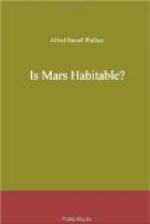On this point I am supported by no less an authority than the historian of modern astronomy, the late Miss Agnes Clerke. In the Edinburgh Review (of October 1896) there is an article entitled ’New Views about Mars,’ exhibiting the writer’s characteristic fulness of knowledge and charm of style. Speaking of Mr. Lowell’s idea of the ‘canals’ carrying the surplus water across the equator, far into the opposite hemisphere, for purposes of irrigation there (which we see he again states in the present volume), Miss Clerke writes: “We can hardly imagine so shrewd a people as the irrigators of Thule and Hellas[6] wasting labour, and the life-giving fluid, after so unprofitable a fashion. There is every reason to believe that the Martian snow-caps are quite flimsy structures. Their material might be called snow souffle, since, owing to the small power of gravity on Mars, snow is almost three times lighter there than here. Consequently, its own weight can have very little effect in rendering it compact. Nor, indeed, is there time for much settling down. The calotte does not form until several months after the winter solstice, and it begins to melt, as a rule, shortly after the vernal equinox. (The interval between these two epochs in the southern hemisphere of Mars is 176 days.) The snow lies on the ground, at the outside, a couple of months. At times it melts while it is still fresh fallen. Thus, at the opposition of 1881-82 the spreading of the northern snows was delayed until seven weeks after the equinox: and they had, accordingly, no sooner reached their maximum than they began to decline. And Professor Pickering’s photographs of April 9th and 10th, 1890, proved that the southern calotte may assume its definitive proportions in a single night.
[Footnote 6: Areas on Mars so named.]
“No attempt has yet been made to estimate the quantity of water derivable from the melting of one of these formations; yet the experiment is worth trying as a help towards defining ideas. Let us grant that the average depth of snow in them, of the delicate Martian kind, is twenty feet, equivalent at the most to one foot of water. The maximum area covered, of 2,400,000 square miles, is nearly equal to that of the United States, while the whole globe of Mars measures 55,500,000 square miles, of which one-third, on the present hypothesis, is under cultivation, and in need of water. Nearly the whole of the dark areas, as we know, are situated in the southern hemisphere, of which they extend over, at the very least, 17,000,000 square miles; that is to say, they cover an area, in round numbers, seven times that of the snow-cap. Only one-seventh of a foot of water, accordingly, could possibly be made available for their fertilisation, supposing them to get the entire advantage of the spring freshet. Upon a stint of less than two inches of water these fertile lands are expected to flourish and bear abundant crops; and since they completely enclose the polar area they are necessarily served first. The great emissaries for carrying off the surplus of their aqueous riches, would then appear to be superfluous constructions, nor is it likely that the share in those riches due to the canals and oases, intricately dividing up the wide, dry, continental plains, can ever be realised.




